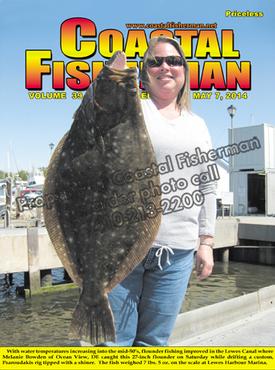


Article by Larry Jock
 New Acoustic Tagging Study to Evaluate Atlantic Striped Bass Migratory Patterns
New Acoustic Tagging Study to Evaluate Atlantic Striped Bass Migratory Patterns
Understanding anadromous fish migration patterns (migrate from sea to freshwater to spawn) and the frequency with which fish return to the tributaries where they were born is important for developing regional stock assessments and management strategies. A long standing question in the assessment and management of coastal striped bass is the migration rates and residency of striped bass produced in the Chesapeake Bay.
Past tagging and aging studies demonstrated that residency and migration fluctuate widely with size, gender and season. However, the data are not detailed enough to be used in stock assessment models designed to analyze trends for multiple regions of the coast (Chesapeake, Delaware, Hudson & New England). Migration and residency pattern studies using conventional fish tags are influenced by tag reporting rates and also fluctuate by year-to-year tag reporting due to environmental conditions in the Chesapeake Bay. Telemetry tagging studies, however, do not rely on tag reporting and use the latest acoustic technology to independently track migrating fish.
Acoustic tags transmit unique sound signals, or pings, that are detected and stored by acoustic telemetry receivers deployed in the water. A unique and timely opportunity exists to utilize telemetry arrays recently deployed at the mouth of the Chesapeake Bay by the U.S. Navy, within the Chesapeake Bay by a NOAA-funded study on Atlantic sturgeon, and broader sharing of tagging data through the new Atlantic Coastal Telemetry Observing System (MATOS). Striped bass, Atlantic sturgeon and other fish outfitted with acoustic tags can now be tracked as they move into and out of the Chesapeake Bay and migrate seasonally in coastal waters, 6 to 10 miles from shore. A new study starting this spring and led by Dr. Dave Secor’s research team at the University of Maryland’s Chesapeake Biological Laboratory (CBL) will place acoustic tags in 100 striped bass, 75 in the spring and 25 in the fall, tracing them for a 2 1/2-year period within the Potomac River and across major regions and tributaries of the Chesapeake Bay and Atlantic coast.
In cooperation with ACT and MATOS, the CBL study will exchange acoustic received and transmitter data collected in the Chesapeake Bay, as well as request from cooperating investigators recapture data from Potomac fish detected in acoustic arrays set-up in the South Atlantic Bight, North Carolina sounds, the Chesapeake, Delaware and Hudson estuaries and the coastal waters from New England through Virginia.
Based upon recapture data, the research team will evaluate a set of hypotheses related to seasonal migration patterns and degree of residency within the Chesapeake Bay including:
• Expected size and sex-specific patterns of outmigration.
•Seasonal timing of outmigration and the influence of temperature and water flow.
• Segregation of resident striped bass in the Potomac River, Chesapeake Bay regions and other tributaries.
• Degree of visitation of outmigrating striped bass to non-natal estuaries (e.g. Delaware, Hudson, North Carolina sounds) and coastal regions.
• Incidence and timing of anadromous spawning runs and the role of temperature and water flow.
The proposed work addresses the key assessment issue of how Chesapeake Bay striped bass contribute to coastal stocks. Within the Chesapeake Bay, the behaviors of tagged fish will be compared to models of available habitat during the summer and fall months. Broader impacts also include predictions of how climate variables (warming water temperatures and flow) influence seasonal striped bass migrations and how fishing seasons may be modified to reflect the migratory patterns of Chesapeake Bay striped bass.
For additional information on the Potomac River striped bass acoustic tagging study, you can contact Dr. Dave Secor at 410-326-7421 or [email protected]. For information and updates on this tagging program visit http://fishconnectivity.cbl.umces.edu/research/connectivity. For information on a variety of Atlantic coast fish tagging programs, visit the Atlantic States Marine Fisheries Commission tagging website at www.fishtag.info.